Your Planets
Portraits of the Planets
Aspects between Planets
The planetary ages
The planetary families
Planets in Signs
The Planets in comics



For more than 2500 years astrologers have had only one concept intuitive and empirical of what the objective reality of an Aspect is. They confined themselves to observing empirically certain real effects and imagining unreal ones. Very rare and very embryonic have been the attempts at conceptualization and therefore at theorization, such as that exposed by Ptolemy in the 2nd century and that proposed by Kepler in the 17th. Both resulted in erroneous explanations and failures. It is only in the 20th century that the concept of Aspect began to be truly elaborate, making it possible to distinguish the true from the false in the antique and traditional notions and formulate a rational explanatory theory through an overall conception of astrology. The contemporary design and graphical representation of the Aspects are the product of a long history, and the very idea of Aspect has evolved over the millennia.
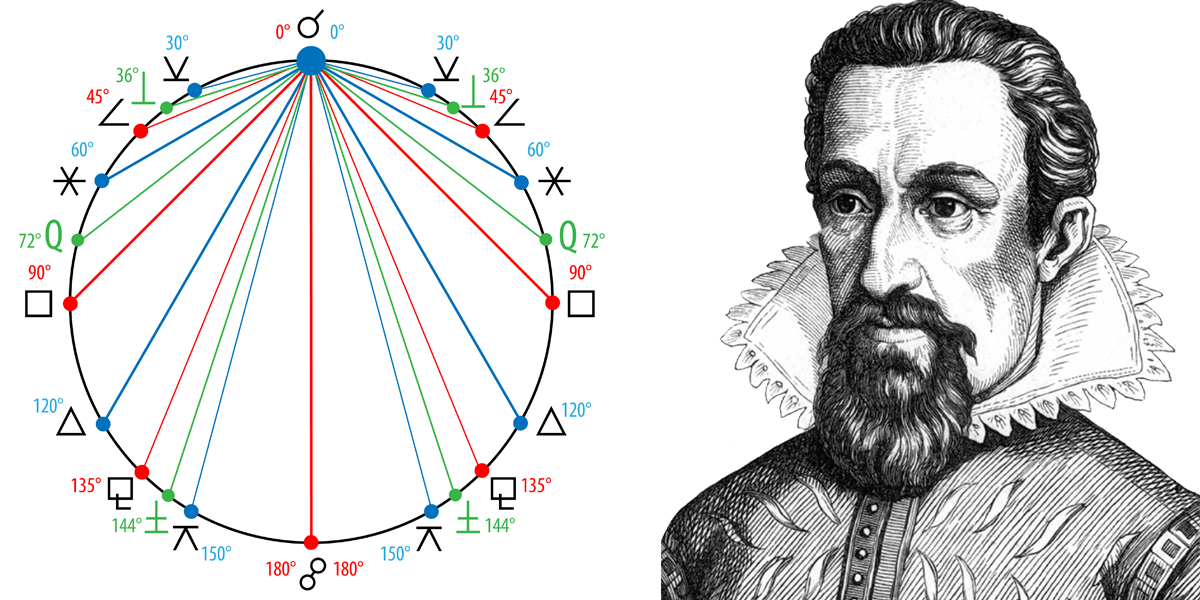
The work of the German astronomer-astrologer Johannes Kepler (1571–1630) is one key moment in the history of science, a century after the Copernican revolution: with Copernicus (1473–1543), we went from geocentrism to heliocentrism and Kepler discovered that planetary orbits were not perfect circles, but ellipses. Faced with this revolution in our conception of the world, astrologers are divided. Many of them have certainly been strong supporters and promoters of heliocentrism; but a large part are opposed to it in that it seems to radically restore the bases of their knowledge, even to ruin it definitively for the most pessimistic.
Astrology is then in full boiling and finds itself tossed in the middle of multiple and contradictory currents. On the one hand, the Planetary aspects with their orbs slowly took a relative autonomy with respect to the zodiacal angles. But on the other hand and in the same period, the translations of Greco-Roman texts during the Renaissance brought back the writings of Ptolemy with their zodiacal angles and made them available to all astrologers who can read Latin. Moreover, these translations had the effect of unexpectedly grafting the doctrine of the 4 Elements on ancient conceptions of the zodiac and the planets. And finally, to crown it all, heliocentrism threatens to undermine at the base the principles on which rested the planetary Aspects which had not come out of their zodiacal matrix for a very long time. There is something to be shaken…
Heliocentrism indeed poses a dreadful problem to the recent conception of the Planetary Aspects. The Earth was thrown out of the central place it had occupied until then in the solar system. However, the planetary Aspects only have reality and meaning from a geocentric point of view: the angles of ecliptic longitude which separate the planets being calculated from the center of the Earth, they no longer have the same existence in a heliocentric frame of reference where the planets form completely different angles between them. They find themselves potentially condemned to be at best only relative appearances, at worst perceptual illusions when in fact, the Aspects are geocentric frequencies which are deduced from heliocentric frequencies.
This new argument will not fail to be put forward by the anti-astrologers of the time, such as the philosopher and theologian Pic de la Mirandole (1463–1493) which reduced the Aspects to a simple optical effect despite his very vague knowledge of astrology and astronomy. This anti-astrological charge did not prevent this devout Catholic devilishly coupled with a passion for hermeticism from asserting that “no science can better convince us of the divinity of Jesus Christ than magic and cabala”, assertion which is a curious esoteric-theological optical effect… Besides condemned by the Roman ecclesiastical authorities, who had many astrologers or astrologers in their ranks! This was for example the case of the popes Jules II (1443–1516), contemporary of Pic de la Mirandola, who made “determine by astrologers the day of his coronation and his return from Bologna” or Paul III (1468–1549), who “never held a consistory without the astrologers having designated the favorable hour for him” if we are to believe the very serious historian Jacob Burckhardt.
What does Kepler think of it, convinced astrologer and nevertheless determining actor of heliocentrism? Well, on this subject as on many others, he flatly refuses to be confused by these arguments. A convinced supporter of the reality and efficiency of geocentric planetary aspects, which he even made the cornerstone of his conception of astrology, this great architect of heliocentrism argues against the heliocentric anti-astrologists of his time. For him simply, “the geometry or harmony of the Aspects is not between the stars in the sky, but rather is down here on Earth at the point that collects all these rays” and “this ability which gives power to the Aspects does not reside in the celestial bodies themselves; for the Aspects… are upon the Earth and are pure figures, whose essence does not arise from planetary motion, but is rather produced by the accidental position of each pair of bodies with respect to the Earth.” And to finish driving this argumentative nail, he specifies that “experience, more than anything else, lends credibility to the effectiveness of Aspects. It is so clear that it can only be denied by those who themselves have not judged them…”
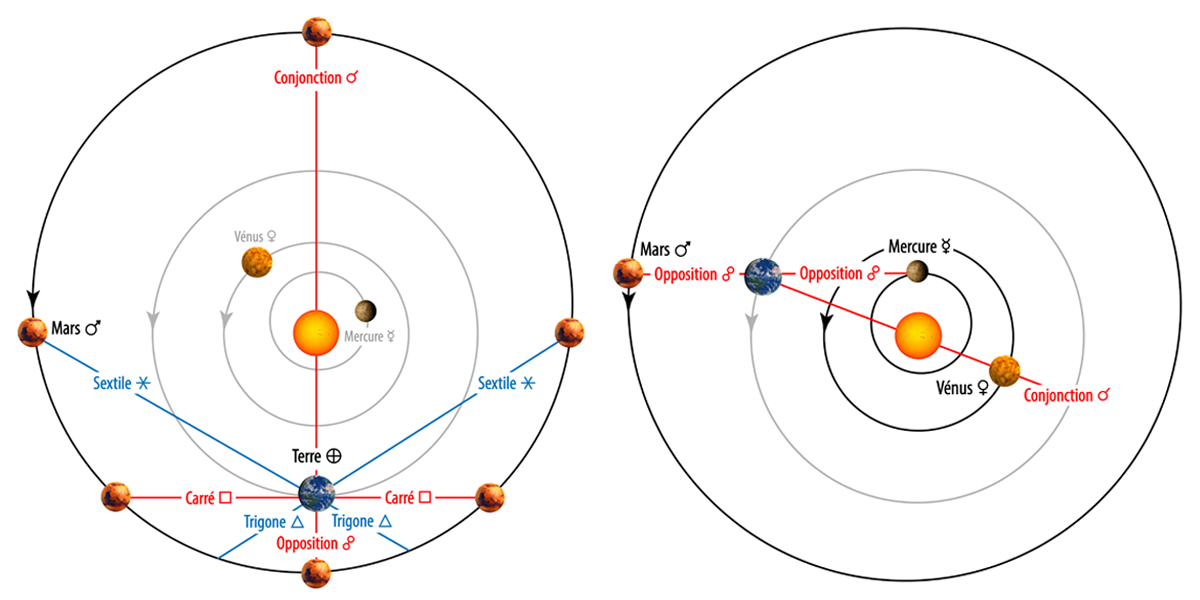
For Kepler therefore, heliocentrism takes nothing away from the reality and the efficiency of the Aspects. Their purely geocentric character is not just an effect of “point of view” in the primary sense of this expression: “panorama, place from which one has the vision of a landscape”. According to him, the Aspects measure — and on this point he is right — the relationships and interactions between planets as they are not only perceived (seen), but also integrated, assimilated, experienced by Earthlings, bodies, souls and spirits combined. From this point of view, whether the Earth is at the center of the solar system or not does not change anything. For Kepler the heliocentrist, the geocentric character of the reality of the Aspects is therefore not a problem.
The video below (10′ 00″) is a commented animation of the notion of Aspect in Kepler.
Kepler operates a radical break from the design of zodiacal angles which prevailed for almost 1500 years. At the same time and in a great reforming impulse, he got rid of the influence attributed to the Houses, rejects (wrongly) the zodiac and therefore abandons the doctrine of Planetary Masteries over the Signs. He thus devotes himself to a great cleaning and a ruthless sorting within the data of the ancient Ptolemaic universe. And at the same time he categorically opposes the doctrine of the 4 Elements which astrologers have adopted over the past two centuries.
In short, Kepler does not do half measures. Here is what he wrote at the beginning of the 17th century: “I completely reject the division into twelve equal Signs, the Houses, the dominations, the triplicities. I retain only the Aspects and bring astrology back to the harmonic doctrine. […] Be that as it may, and even if I quite rightly enjoy this very ingenious imitation of nature and this distribution of qualities between Signs, I still do not attach more value to it than it does. do not deserve; and it is not because the first authors borrowed a law from nature for their arbitrary speculations, that in return the nature of celestial things submitted in everything to their speculations… It appears rather from attentive examination of the causes (denominations) that the Signs of the zodiac have received the name of the Elements only because of arbitrary inventions; and that in reality they are not linked by any particular relationship with the Elements which served to name them.”
In this text, Kepler writes without ambiguity that he does not retain from the Ptolemaic heritage “only the Aspects and brings astrology back to the harmonic doctrine”. The Ptolemaic Aspects he evokes being in fact, as we have seen, zodiacal angles, which is to say that he kept practically nothing of this centuries-old legacy. But the formulation of his sentence confirms to us that in his time, the zodiacal angles had perhaps been converted into Interplanetary Aspects, at least in the minds of some learned astrologers, to the point for Kepler to pretend that Ptolemy was dealing with interplanetary aspects when he only considered zodiacal angles. But the work of Robert Fludd (1574–1637), an English Rosicrucian astrologer, physician and mystic contemporary to Kepler, shows that zodiacal angles were probably still the norm at the same time. Indeed, here is what we can read in his General astrology treatise published in the 17th century: “Two planets are said to be in Aspect when they communicate their qualities to each other through the zodiacal signs.”
It will be observed that Kepler’s position on the zodiac and the 4 Elements evolved during his lifetime… and his food concerns. So in 1603 he saw significance in the fact that the Jupiter/Saturn conjunction of that year, which occurs approximately every 59.6 years in different Elements and approximately every 200 years in the “trine of fire” Aries-Leo-Sagittarius: “It is truly remarkable that the most significant periods appear at approximately the same time periods” (letter to a friend). But he stood out from contemporary astrologers by carefully making these astronomical events only “coincident events”, and not effects.
In the same register but for a different reason, he evoked in his almanac his forecasts for the winter of 1618 (thus very late in his life): “there could be rain or snow, the causes being Venus and Mercury in Sagittarius”, which goes against the rejection of the zodiac he then displayed in his scholarly astrological writings. In this case, it is clear that he was complying with the commercial astrology standards to do boil his family’s pot, and it was not lightheartedly: thus, in a letter to his friend Michael Maestlin, he expressed his concern that his food work on prediction almanacs would damage his scientific reputation. But it was necessary to earn its crust and “well, nobody’s perfect”…
And then it allowed subsequent generations of history-falsifying anti-astrologists to make their honey of an excerpt from Kepler’s letter about his almanacs: “What do you complain about if a daughter you think is crazy [astrology] supports and nurtures a wise but poor mother [astronomy]? […] If one had not had the gullible hope of reading the future in the sky, would you ever have been wise enough to study astronomy for its own sake?”… using this quote to claim that he only saw astrology as a source of additional income when until his last breath, he was always a convinced and practicing astrologer.
For Kepler therefore, Astrology is a knowledge whose object is exclusively the study of the Planets, their Aspects and their influences. This was a conception of revolutionary astrology, which he was almost the only one to share.
The Aspects are for him uniquely determined by their ecliptic longitudes. He never mentions their latitudes in his astrological texts. It recognizes the necessity and the reality of orbs, as evidenced for example by these extracts from the interpretation he makes of his own Birth Chart: “the Sun in sextile with Saturn signifies care and tenacity.” Now this Aspect formed an angle of more than 61°. He also admits an orb of almost 3° for his Mercury-Mars square when he writes that “If Mercury is in aspect with Mars as it is, Mars terrifies it; then the mind becomes too quick, inclined to anger, to gambling, to distractions, to having fusses, quarrels, to commit sins, to let nothing stop it, to meddle in everything: there is everything this at our native” (the “native” in question, it is of course he who objects).
The spontaneous way he has of evoking these Aspects with orbs and the fact that he himself did not theorize this phenomenon suggests that this practice was probably quite widespread among the astrologers of his time and that it made it his own as if it constituted an evidence on which there was no going back, and on which his very critical mind has not been exercised.
Add to this that he mentions “Mercury in House VII” Who “means speed and distaste for work, because he himself is in motion”, and we will also know that, like Ptolemy, he considers the planetary angularities as decisive. Indeed, since Kepler rejects the meanings traditionally attributed to the Houses, this mention of Mercury in VII, therefore close to the Descendant (of its setting) only makes sense when considering that House VII is one of those that can contain the planets close to the Angles of the local sphere (AS, MC, DS, IC). NB: We know two different versions of his birth time.
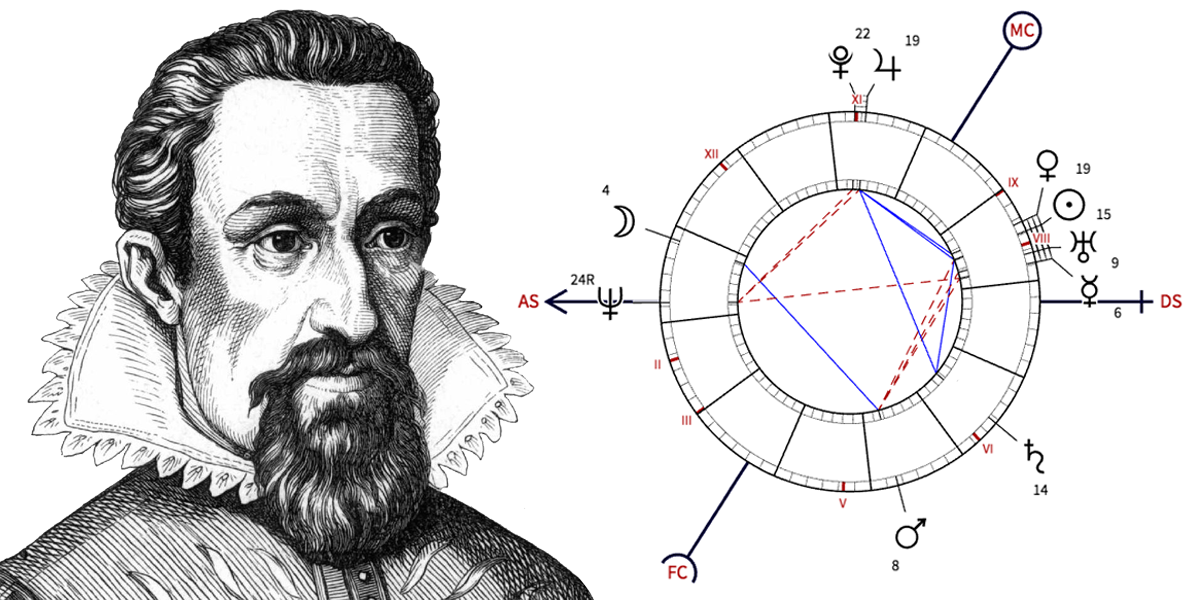
In yet another text, he repeats that “the Aspects are the only kind of thing I retain from astrology — and I put as much into it, in the name of harmonic doctrine and philosophy, as I show stamina to uphold as the rest of the kitchen astrologers is almost entirely to be eliminated.” It is time, therefore, to carefully consider what he means by this mysterious “harmonic doctrine” which he explained in his book Improved fundamentals of astrology.
In his Tetrabiblos, Ptolemy briefly pointed out the kinship between the zodiacal angles and the strings of musical instruments, the length of which produced harmonic chords. This was a consideration marked by the seal of Pythagoras, who was the first to link numbers to music, arguing that a harmonious musical impression could “be explained mathematically”, the laws of the harmony of numbers being reflected in those of music, and vice versa. Kepler took over this correlation and then rushed around 1602 into astro-mathematical-musicological research in order to build a solid theory of the Aspects on these bases.
The zodiacal angles of Ptolemy, which Kepler adopted by transposing them from the Signs to the planets, were based on the division of the 360° of the zodiacal circle by the whole numbers 1 (conjunction), 2 (opposition), 3 (trine), 4 (square) and 6 (sextile). According to Ptolemy, let us recall, the divisions of the circle on which these 5 zodiacal angles “major” had the property of being able to include straight lines and regular polygons geometrically distributed according to the 12 Signs. But Kepler had a planetary design of the Aspects and he rejected the limits traditionally assigned to the twelve Signs. According to him, “it appears that this ancient division of the zodiac into twelve equal parts rests mainly on human arbitrariness, and that the Signs in reality or naturally are not so precisely separated from each other, or that their characteristics, as defined by these limits, overlap.”
Therefore, without abandoning the geometric design of the Aspects (geometry was sacred to him), he is silent freed from the numerical constraints required by the positioning of regular polygons in a circle. He could imagine and invent other Aspects in an attempt to make them correspond to the Pythagorean laws of musical harmony. Its design both geometric and kinematic musical intervals forced him to think of the Aspects in terms of cycles and therefore durations.
He therefore gradually freed himself from regular polygons, nevertheless mysteriously forcing himself to contain his numeric-musicological explorations within the limits of the denominator 10. By remaining within this limit and within the spectrum of whole numbers as well as Aspects making it possible to form polygons regular, he thus admitted the semi-square (360°/8 = 45°), but first rejected the semi-sextile (360°/12 = 30°) then ends up adopting it later. By leaving this specter and growing bolder until drop regular polygons, he invented the decile (360°/10 = 36°) and the quintile (360°/5 = 72°). It was perhaps these two new Aspects that led him to go even further, this time passing fractions to integers, which gave rise to the biquintile (360°/2.5 = 144°). After which the door was opened to all possible and imaginable Aspects: the trioctile or sesquisquare (360°/8 × 3), the tridecile (360°/10 × 3 = 108°), the quincunx (360°/2.4 = (150°), etc.
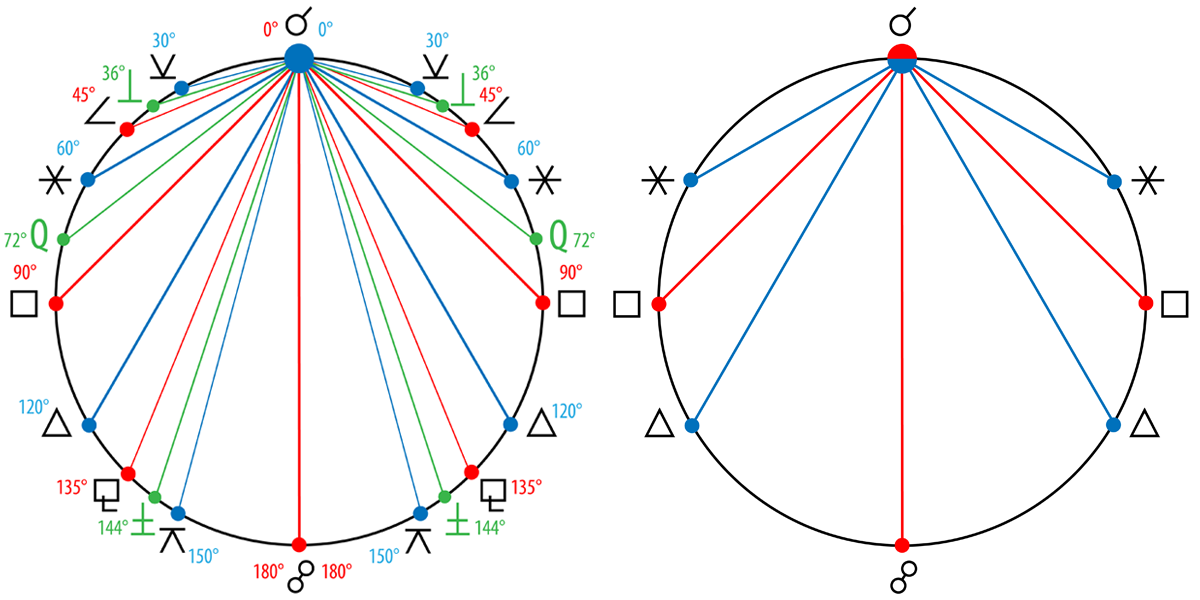
Kepler soon found himself overwhelmed by the tide of minor and hyper-minor Aspects that he had created. Some corresponded roughly to musical harmonics and some did not. He also applied them to the meteorology, because at that time climate prediction was astrology and he did not hesitate to use it in order to more or less (rather less than more) predict the rain and the good weather. These new Aspects proved incapable of systematically forecasting storms. The interpretation of their hypothetical effects in the Natal Charts did not help either. And after long years of research and observation, he finally gradually and reluctantly abandoning this track.
In the preface to his Ephemerides for the year 1617, he wrote that apart from the 5 major Aspects, he no longer admitted any other apart from the semi-sextile of 30°, the quintile of 72° and the biquintile of 144°, while noting that “Nevertheless, whenever I observe storms, the 150° stagger also seems to be very strong.” And finally, in the Ephemerides of the new celestial movements from the year 1617 to the year 1628 which will be published in 1630, the year of his death, he finally announces that he abandons all reference to music in the quest for “harmonic doctrine” of the Aspects, to which he devoted so many years. He does this by noting bitterly that it is among other things “because the sesquisquare is suitable for music, but the semi-sextile is not, and the latter is efficient, but the former is not.” He will have tried until the end.
What conclusions can be drawn from this search for “harmonic doctrine” aspects? One would be tempted to answer with another question: “All that for this?” But that would be partially unfair. It was a paradoxically fruitful failure, in that it allowed, for the first time in the history of astrology, to explore the field of planetary Aspects in total independence from the zodiac. Thanks to Kepler, the Planetary Aspect has become an element in itself and it has become legitimate to choose to interpret a Natal Chart based exclusively on this element.
This is how he was able to observe, rightly or wrongly, that “people born at the time of many planetary Aspects generally become industrious and restless — whether they become accustomed from childhood to acquiring wealth, whether they were born or destined to be active in public life, or they are dedicated to learning… The natal horoscope is a wonderful thing.” From this point of view, he made a powerful contribution to get astrology out of its zodiac rut: after all, aren’t the planets, their positions and their moving Aspects the first element and essential of which the Signs are only phases? And finally, this failure confirmed the capital importance of the 5 Major Aspects, whose long and scrupulous observations of Kepler made it possible to validate the merits.
Admittedly, he did not address the astrological problem of the ecliptic latitudes of the Aspects. He didn’t for two reasons. On the one hand, they were incompatible with the harmonic doctrine he was looking for: their introduction would automatically have been a source of disharmonious discrepancies. And on the other hand because Kepler was a moving being in a planetary world that is also always moving, and that he thus considered the Aspects as the phases of a cycle, and no longer like angles frozen in a geometric absolute. Didn’t he say that “the laws and periods of the cycles should be investigated by collecting observations made over many years”?
However, the cycles and intercycles are characterized by the periodic return of particular astral configurations, put on the same plane in order to be able to calculate and predict their phases (the Aspects in longitude, precisely). From this point of view, only eclipses require the ecliptic latitudes to be taken into account, in order to predict the precise dates of occultation that they cause and the partial or total nature of these occultations. And precisely, Kepler has devised mathematical methods to significantly improve these precisions. It is therefore knowingly that he neglected the ecliptic latitudes outside of these specific cases. And three centuries later, it was vindicated that he was right. But let’s not anticipate: we will first have to see what happened in the design of the Aspects between the 17th and 20th centuries.
Too busy in his task of heliocentric reform of the laws of astronomy, Kepler did not have time to bring to an end that of astrology which he envisaged. He only left the fragmentary sketch which draws an astrology reduced to the sole planets and their Aspects. As he did not write a treatise or manual precisely describing the new conception he had of it at the end of his life, he did not have a school and no astrologer followed the path he had traced. Those who knew of his fruitless research remembered only some of the Minor Aspects he invented and then discarded. To expand their interpretive panoply, they added them to Ptolemy’s five majors regardless of the quest for harmonic doctrine that was behind their creation.
Note however, to Kepler’s credit, that three of the Aspects he imagined deserve to be retained: the decil (36°), the quintile (72°) and the biquintil (144°). They deserve it not for their importance or their supposed efficiency, but because they belong to the same harmonic family as the Major Aspects of Ptolemy. It’s the astrologer Jean-Pierre Nicola who lifted this hare in the 20th century.
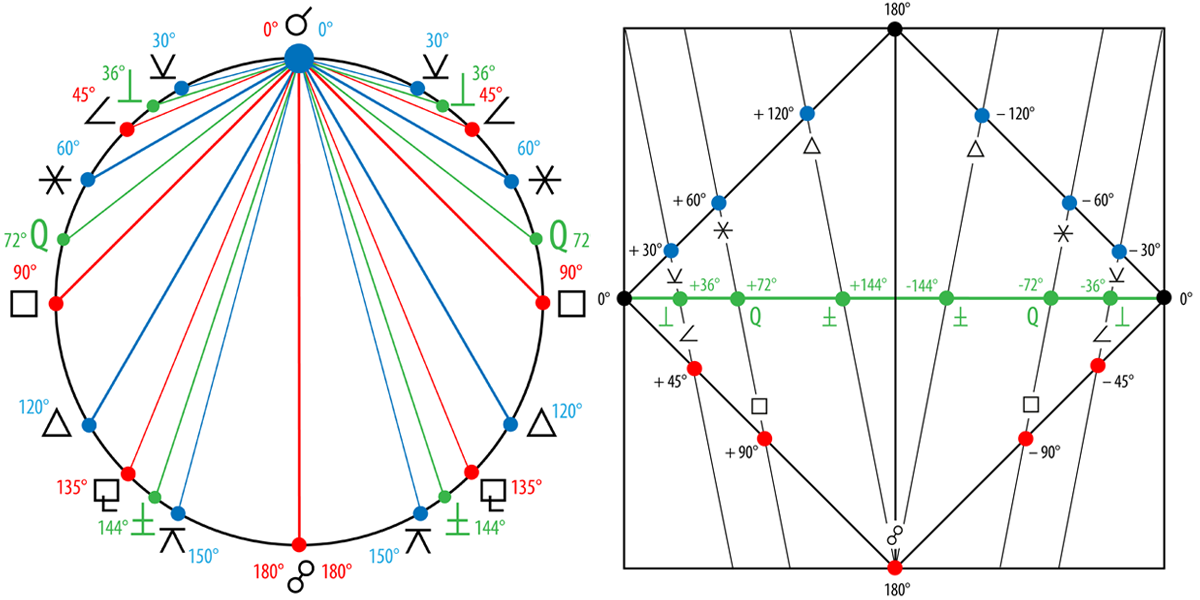
Kepler’s major contribution will therefore have been to put an end to the static zodiacal angles frozen in a geometric space to convert them into kinematic interplanetary Aspects, frequencies-phases of cycles and intercycles. Her major mistake will have been to reject the zodiac because he didn’t have found none natural explanatory (while Ptolemy himself had partially discovered one by taking into account the declinations) and he rejected his division into 12 Signs as much as the doctrine of the 4 Elements which had been placed on it a century before him.
▶ Aspects theory and practice
▶ Les aspects, phases d’un cycle
▶ Aspects : existe-t-il un modèle traditionnel ?
▶ Aspects : théorie et bilan conditionaliste
▶ Introduction à l’interprétation des aspects
▶ The planetary Aspects and their orbs
▶ Les Aspects kepleriens
▶ Les “aspects” aux Angles
▶ Chronologie des Aspects et Transits
▶ Les Aspects planétaires
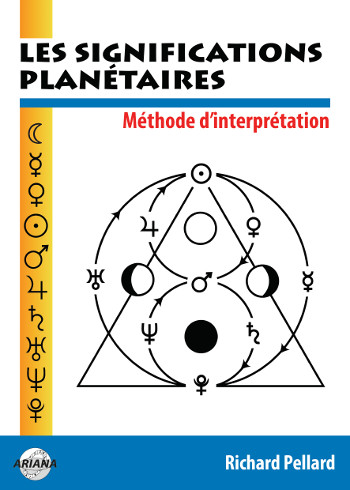
Les significations planétaires
par
620 pages. Illustrations en couleur.
La décision de ne traiter dans ce livre que des significations planétaires ne repose pas sur une sous-estimation du rôle des Signes du zodiaque et des Maisons. Le traditionnel trio Planètes-Zodiaque-Maisons est en effet l’expression d’une structure qui classe ces trois plans selon leur ordre de préséance et dans ce triptyque hiérarchisé, les Planètes occupent le premier rang.
La première partie de ce livre rassemble donc, sous une forme abondamment illustrée de schémas pédagogiques et tableaux explicatifs, une édition originale revue, augmentée et actualisée des textes consacrés aux significations planétaires telles qu’elles ont été définies par l’astrologie conditionaliste et une présentation détaillée des méthodes de hiérarchisation planétaire et d’interprétation accompagnées de nombreux exemples concrets illustrés par des Thèmes de célébrités.
La deuxième partie est consacrée, d’une part à une présentation critique des fondements traditionnels des significations planétaires, d’autre part à une présentation des rapports entre signaux et symboles, astrologie et psychologie. Enfin, la troisième partie présente brièvement les racines astrométriques des significations planétaires… et propose une voie de sortie de l’astrologie pour accéder à une plus vaste dimension noologique et spirituelle qui la prolonge et la contient.
Téléchargez-le dès maintenant dans notre boutique
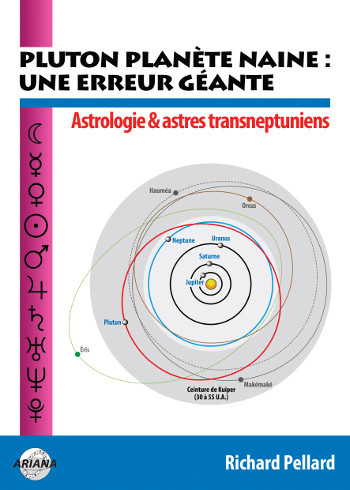
Pluton planète naine : une erreur géante
par
117 pages. Illustrations en couleur.
Pluton ne fait plus partie des planètes majeures de notre système solaire : telle est la décision prise par une infime minorité d’astronomes lors de l’Assemblée Générale de l’Union Astronomique Internationale qui s’est tenue à Prague en août 2006. Elle est reléguée au rang de “planète naine”, au même titre que les nombreux astres découverts au-delà de son orbite.
Ce livre récapitule et analyse en détail le pourquoi et le comment de cette incroyable et irrationnelle décision contestée par de très nombreux astronomes de premier plan. Quelles sont les effets de cette “nanification” de Pluton sur son statut astrologique ? Faut-il remettre en question son influence et ses significations astro-psychologiques qui semblaient avérées depuis sa découverte en 1930 ? Les “plutoniens” ont-ils cessé d’exister depuis cette décision charlatanesque ? Ce livre pose également le problème des astres transplutoniens nouvellement découverts. Quel statut astrologique et quelles influences et significations précises leur accorder ?
Enfin, cet ouvrage propose une vision unitaire du système solaire qui démontre, chiffes et arguments rationnels à l’appui, que Pluton en est toujours un élément essentiel, ce qui est loin d’être le cas pour les autres astres au-delà de son orbite. Après avoir lu ce livre, vous saurez quoi répondre à ceux qui pensent avoir trouvé, avec l’exclusion de Pluton du cortège planétaire traditionnel, un nouvel argument contre l’astrologie !
Téléchargez-le dès maintenant dans notre boutique